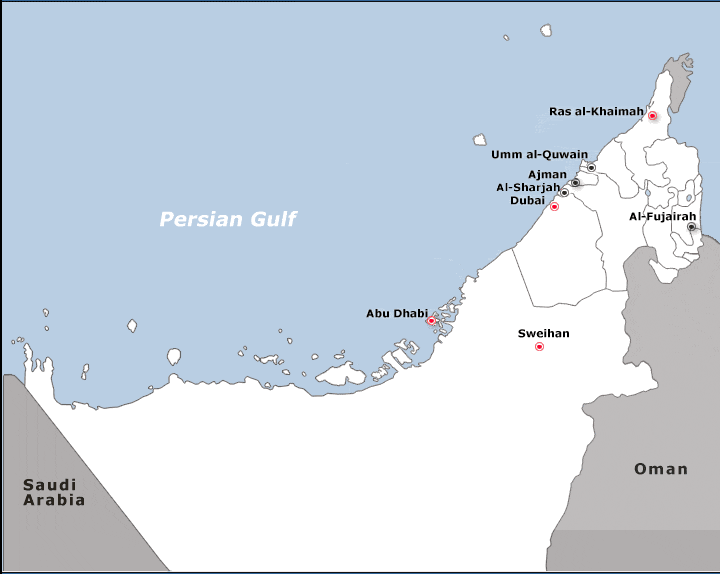Before oil was discovered in Abu Dhabi in the 1950s, the region was known for fishing, the pearl trade, agriculture and herding. Following the expansion of the oil industry, the United Arab Emirates has vastly changed. Once a region predominantly inhabited by nomadic Bedouin tribes, the country has become a global hub for trade and tourism. Expatriates and migrant workers now make up 80 percent of the country’s population. Inspired by the Singapore model, the UAE has introduced special tax incentives, which have attracted thousands of companies from over 120 countries.
 Sources: Human Rights Watch; The Times of India; Al Jazeera English; DubaiCamelJockeys.org; UAEinteract.com. |
Renewable Energy: Abu Dhabi
When completed in 2015, the city will include housing for 47,000 people to live in a network of pedestrian streets with rooftops covered by energy-producing solar panels. The Masdar Initiative, which means “source” in Arabic, will also include a new university that will offer doctoral and masters degree programs in sustainable design.
Some of the world’s biggest energy companies are involved in the initiative, including Shell, BP, General Electric, and Occidental Petroleum. The initiative involves the commercialization of technology in carbon management, water usage, renewable energy, and desalination, all of which the UAE depends on as it continues to grow and consume energy. This multi-million dollar effort is only a first step in the UAE’s series of plans toward cleaner energy implementation.
Education: Al-Sharjah
its citizens with education from kindergarten to the university level, although thousands of
students pursue degrees in higher education abroad at the government’s expense, a common practice
in Gulf Countries.
The government tries to provide a staff to student ratio of 1 to 20 at the kindergarten and primary
levels, and 1 to 15 at the intermediate and secondary levels.
The United Arab Emirates University (UAEU) is the nation’s top university for higher education, but schools such as Zayed University, which
was established in 1998 to help advance women’s role in society, are becoming increasingly popular.
Migrant Workers: Dubai
These blue-collar workers are an exploited underclass with few rights. According to a recent Human Rights Watch Report, serious labor violations include extremely low wages, withholding pay and passports, and hazardous working conditions that lead to death and injury. The workers live in labor camps and seedy apartments, sometimes up to 20 in a room that is 40 square feet in size. In their off hours they are restricted to certain parts of the city.
During the past year, migrant workers have increasingly resorted to strikes in an attempt to improve working conditions. As a result, the UAE has taken certain measures such as hiring 2,000 labor inspectors and forcing companies to pay $52 million in unpaid wages. Employers, however, are not held accountable and continue to build, and break the law.
Sources: Human Rights Watch
Ras Al-Khaimah
Vast artificial islands are being created throughout the Emirates to fashion additional coastlines, building resorts, theme parks, and shopping malls. Ras al-Khaimah’s neighboring state, Dubai, has already built islands in the shape of palm trees, Arabic poems, and maps of the world — adding 900 miles to its original coastline.
Developers of these man-made islands are increasingly coming under fire from environmental organizations, who say that the islands upset the entire ecology of the western Persian Gulf. They argue that as a result of these developments beaches are slowly starting to erode, coral reefs and turtle nesting grounds have been damaged, and natural currents have been rerouted. The developers insist that new sea life will thrive on the islands’ artificial reefs.
Sweihan
In July 2007, the story appeared in the news again as a Miami couple filed a lawsuit against Dubai’s Sheikh Mohammed bin Rashed al-Maktoum alleging he had kidnapped and enslaved children for the purpose of racing camels. The couple seeks unspecified compensatory and punitive damages for the alleged abuse of their children. The Dubai ruler sought help from President George Bush in dismissing the complaint, and threatened that this could affect ties between the two countries.
Source: Al Jazeera English, DubaiCamelJockeys.org
Environment: Umm Al Quwain
Vast artificial islands are being created throughout the emirates to fashion additional coastlines to build resorts, theme parks, and shopping malls. Ras al-KhaimahÕs neighboring state, Dubai, has already built islands in the shape of palm trees, Arabic poems, and maps of the world, adding 900 miles to its original coastline.
Developers of these man-made islands are increasingly coming under fire from environmental organizations, who say that the islands upset the entire ecology of the western Persian Gulf. They argue that as a result of these developments beaches are slowly starting to erode, coral reefs and turtle nesting grounds have been damaged, and natural currents have been rerouted. The developers insist that new sea life will thrive on the islands’ artificial reefs.
Sources: BBC
